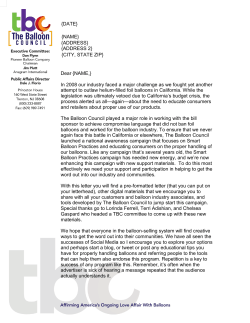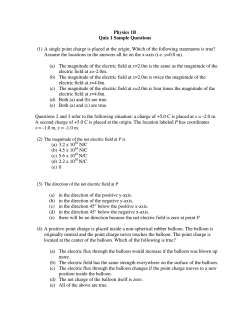
Cellular Respiration Student Worksheet
Student Resource Name: ________________________________ Period:_____ Date: _______________ Teacher’s Name: ________________________ Course: ________________________ Cellular Respiration Lab Introduction: Cellular respiration is the process that allows cells to convert glucose (sugar broken down from food sources) into energy. Aerobic cellular respiration takes place in the presence of oxygen and produces carbon dioxide and water as byproducts. In this experiment we will use yeast, unicellular eukaryotic organisms, to demonstrate cellular respiration. Consider the following chemical reaction: + Energy (ATP) + Energy (ATP) What are the byproducts of the sugar, glucose ( and oxygen (? Write your answers here and include whether you think they are solid (s), liquid (l), gas (g) or aqueous (aq): ____________________________ You also carry out this chemical reaction. After completing this experiment, try blowing up a balloon yourself – you breathe in oxygen and exhale carbon dioxide due to this process of cellular respiration. Once you have inflated your two experimental balloons you can follow the instructions for “detecting carbon dioxide.” Purpose: In this lab we will gather evidence for or against yeast and humans releasing CO2 when respiring. Materials (per group): 2 balloons 1 packet of active yeast 2, 125 mL Erlenmeyer flasks 2 straws Lime water 1, 500 mL Erlenmeyer flask BTB in Sugar gas probe (if accessible) ! Performing Cellular Respiration (use the right-hand box for notes and observations). Ocean Acidification: A Systems Approach to a Global Problem І Lesson 2 " Student Resource 1. Measure 300mL of lukewarm water in a 500mL Erlenmeyer flask. Dissolve 5 grams of sugar into the flask. Add 1 packet of yeast to the flask. " 2. Immediately stretch a balloon over the top of the flask. " 3. The balloon will begin to inflate during the first five minutes after the sugar water is inoculated with yeast. Allow the yeast about twenty-five minutes to inflate the balloon. Meanwhile consider the chemical formula for cellular respiration and make predictions about what gas is filling the inflating balloon. Discuss how you could test your hypothesis and answer the questions below. " 4. Take your other balloon and exhale into it to blow up the balloon. Tie it off and save it for Lab Station B – detecting CO 4. Gently remove the balloon from the flask with the yeast. To do so, twist the inflated balloon while securing the elastic lip. Then squeeze the twisted balloon and slide the lip off of the flask. Be careful not to let any gas leak from the balloon. " Ocean Acidification: A Systems Approach to a Global Problem І Lesson 2 " Student Resource 1. Do you think a chemical reaction has occurred? Why or why not – give evidence to defend your answer. ! ! ! ! 2. What do you think has been captured in the balloon? Be specific and explain your answer. ! ! ! ! ! 3. Clean up your space and then take your balloon to lab station B to identify the substance in your balloon. Ocean Acidification: A Systems Approach to a Global Problem І Lesson 2 "
© Copyright 2025
















